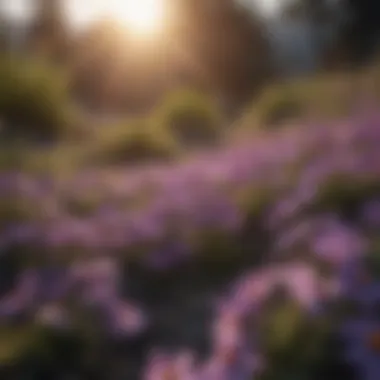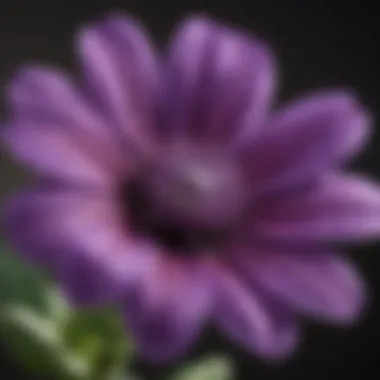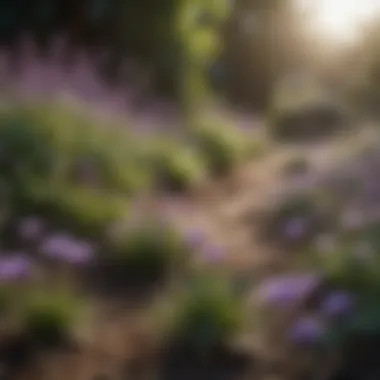Exploring Stunning Purple Flowers for Full Sun Gardens


Intro
Purple flowers are a visual delight in gardens, offering vibrant colors that captivate the eye. For gardening enthusiasts, the study of these blooms that thrive in full sun conditions is significant. These flowers not only enhance the aesthetic value of landscapes but also fulfill various ecological roles. Their ability to flourish under intense sunlight makes them ideal for creating lively garden spaces.
In this guide, we will explore the different species of purple flowers that perform best in sunny locations. We will detail their specific growth requirements, share insights into their environmental preferences, and discuss how to use them effectively in landscaping. This exploration aims to provide a comprehensive understanding while also highlighting their beauty and ecological contributions.
Growth Requirements of Purple Flowers
When selecting purple flowers for full sun conditions, it is essential to consider the following growth requirements:
- Soil Type: Most purple flowers prefer well-drained soil. Sandy or loamy soils are often optimal, allowing for proper drainage and root development.
- Water Needs: These flowers typically require moderate watering. Overwatering can lead to root rot, while underwatering may stress the plants.
- Sun Exposure: Full sun means at least six to eight hours of direct sunlight daily. This ensures robust growth and vibrant blooms.
Environmental Preferences
Understanding the environmental needs of your chosen purple flowers is crucial for successful cultivation:
- Temperature Tolerance: Many purple-flowering plants can tolerate heat but require protection from extreme cold during winter months.
- Nutrient Requirements: Regular feeding can enhance blooming. A balanced fertilizer during the growing season helps in achieving lush foliage and flowers.
- Pest Resistance: Certain species are more resilient to pests and diseases. Choosing pest-resistant varieties can minimize maintenance needs.
Popular Full Sun Purple Flowers
Several species stand out for their beauty and resilience in sunny spots:
- Lavender (Lavandula): Renowned for its fragrant flowers, lavender is drought-tolerant and thrives in well-drained soil.
- Salvia (Salvia spp.): This perennial plant attracts pollinators and offers stunning purple spikes in various shades.
- Aster (Aster spp.): Known for its late-summer blooms, aster is great for adding color as other flowers fade.
- Verbena (Verbena spp.): With cascading blooms, verbena works well in hanging baskets and provides a continuous display of color.
Landscaping Uses
Incorporating purple flowers into landscaping can create stunning visual impacts:
- Borders and Edges: Planting purple flowers along garden borders adds depth and definition.
- Accent Pieces: Use taller varieties like aster or salvia as backdrop plants, complemented by shorter ones.
- Pollinator Gardens: Creating a habitat for bees and butterflies can enhance the ecological balance in your garden.
Intro to Full Sun Purple Flowers
Understanding full sun purple flowers is crucial for gardeners who aim to create vibrant and visually appealing landscapes. These flowers not only add color but also offer a variety of benefits in terms of ecology and aesthetics. Choosing plants that thrive in full sun means ensuring they receive at least six hours of direct sunlight each day. This requirement influences the selection process when designing a garden. Furthermore, purple flowers can elevate the visual interest in a garden by providing depth and contrast against green foliage.
Defining Full Sun Exposure
Full sun exposure refers to the amount of direct sunlight a plant requires for optimal growth. In horticulture, this is generally considered to be at least six hours of sunlight per day. Sun exposure not only affects flowering but also overall plant health, growth rates, and the vibrancy of colors. Gardeners must assess their garden's sun patterns throughout the day and season to choose the best locations for these plants.
Significance of Purple Flowers in Gardens
Purple flowers play an important role in gardening. Their rich hues can complement a multitude of other colors, enhancing the overall beauty of a landscape. Additionally, they often attract pollinators, such as bees and butterflies, making them vital for ecosystem health. Including purple flowers can also elevate the cultural significance of a garden, as many cultures associate purple with nobility, luxury, and creativity. This can enhance a garden's emotional impact on those who experience it.
Characteristics of Full Sun Purple Flowers
Understanding the characteristics of full sun purple flowers is crucial for anyone interested in creating a vibrant garden. These flowers not only enhance the visual appeal of landscapes but also fulfill specific growth requirements and environmental preferences. One may wonder about their growth habits or the timing of their blooms. This section aims to delve into these elements, illustrating their significance in horticulture and offering insights that will benefit both novice and seasoned gardeners alike.
Growth Habit and Size
Growth habit refers to how a plant develops over time. For full sun purple flowers, this can vary significantly across different species. Many of these flowers are chosen for their robust structure and resilience, making them ideal for sunny environments.
- Upright Plants: Some flowers, like the Purple Coneflower, grow tall and straight, creating vertical interest in a garden. They can reach heights of up to four feet, depending on the variety.
- Spreading Varieties: Others, such as Creeping Phlox, have a more sprawling growth habit. This makes them suitable as ground covers, hence helping in weed suppression.
- Container Options: Some purple flowers thrive in pots and can be moved to capture maximum sunlight. Varieties such as Petunias can adapt well to container gardening.


Understanding these growth patterns can influence not just the aesthetic but also the functionality of the garden. Knowing the expected size can help in planning space and interaction among different plants.
Blooming Season and Duration
The blooming season of full sun purple flowers is another essential aspect for gardeners to consider. Different species have varied blooming times, which can either extend the flower show throughout the growing season or provide bursts of color at specific intervals.
- Spring Bloomers: Certain flowers like Asters start flowering as spring settles in, adding early season interest to the garden.
- Summer Favorites: Flowers such as Lavender peak in the mid to late summer, offering aromatic blooms that draw both human admiration and pollinators.
- Autumn Showstoppers: Some species, including certain Chrysanthemums, can extend the blooming period well into fall, providing color after many other plants have faded.
The duration of the blooms varies too. While some flowers like the Salvia bloom continuously until the first frost, others may only bloom for a few weeks. This diversity in blooming times allows gardeners to curate a continuously changing landscape, ensuring that there is always something in flower.
Choosing flowers with different blooming seasons ensures that your garden remains vibrant throughout the growing months.
By understanding these characteristics, you can make informed choices when selecting purple flowers for full sun areas. This knowledge not only enhances the aesthetic value but also maximizes the ecological benefits of your garden.
Popular Varieties of Purple Flowers for Sunny Areas
Purple flowers suitable for full sun are not just visually appealing; they serve a vital role in gardens and landscapes. These plants are known for their resilience and ability to thrive in harsh sunlight, making them suitable choices for both seasoned gardeners and novices. Each variety offers unique aesthetics and ecological benefits, enhancing not only the beauty of a space but also its health.
Lavender: Aromatic and Versatile
Lavender is arguably one of the most popular purple flowers known for its fragrant blooms. Growing to about 1 to 3 feet in height, this perennial thrives in well-drained soil and enjoys ample sunlight. Its few care requirements make it ideal for busy individuals who still wish to bring beauty into their spaces.
In addition to its aromatic properties, lavender supports a diverse range of pollinators, enhancing local biodiversity. It is often used in landscaping as a border or a focal point due to its striking color and pleasant scent. Moreover, the dried flowers can be harvested for crafts or culinary uses, making lavender a versatile choice for various gardening enthusiasts.
Purple Coneflower: Resilient and Attractive
The Purple Coneflower, or Echinacea purpurea, stands out for its unique daisy-like shape and vibrant color. It can reach heights of 2 to 4 feet and offers extended blooming from mid-summer to fall. This flower is known for its ability to withstand drought conditions, needing minimal watering once established.
More remarkably, these flowers are not only stunning but also attractive to pollinators like bees and butterflies. They have medicinal properties too, often utilized in herbal remedies to boost immunity. Their structural integrity allows them to maintain their form even in harsh weather, making Purple Coneflowers a staple in resilient gardens.
Aster: A Late Summer Bloom
Asters are well-regarded for their late-summer blooms, injecting a burst of color into gardens as the season transitions towards fall. They typically grow between 1 to 4 feet tall, depending on the species, and flourish in full sun conditions.
These flowers exhibit different hues of purple and can generate a wealth of interest in any landscape. Asters attract various beneficial insects, playing an essential role in pollination while adding depth and texture to garden designs. Furthermore, their blooming timeline allows for continuity in garden aesthetics, extending the visual interest through the changing seasons.
Salvia: A Pollinator's Paradise
Salvia, commonly known as sage, is another worthy contender among full sun purple flowers. With many species available, these plants can architectural points in gardens, with heights varying from 12 inches to over 3 feet. Salvia thrives on moderate watering and well-aerated soil, making it relatively easy to care for.
The flowers not only charm humans with their bold colors but also attract a variety of pollinators, including hummingbirds and bees. This unique ecological benefit can contribute to healthier garden ecosystems. Moreover, many varieties also possess culinary uses, adding layers of utility to their presence in home gardens.
"Choosing the right purple flowers for sunny areas is essential in creating both visually stunning and ecologically beneficial landscapes."
Cultivation Requirements
Understanding cultivation requirements is crucial for ensuring the success of purple flowers in sunny areas. Cultivation encompasses various elements including soil type, water, and fertilization needs. To grow these flowers effectively, it is important to cater to their specific needs. Proper attention to these details not only enhances plant health but also boosts their aesthetic and ecological potential.
Soil Type and Preparation
Soil plays a pivotal role in the growth of purple flowers. Most species thrive in well-draining soils over heavy, compact types. For example, sandy loam or clay soils with organic matter are often ideal. Here are essential considerations:
- pH Levels: Most purple flowers prefer a slightly acidic to neutral pH (within 6.0 to 7.0). Testing your soil's pH can guide necessary amendments.
- Texture: A balance of sand, silt, and clay can provide beneficial drainage while retaining necessary moisture.
- Preparation: Proper soil preparation involves tilling the soil to aerate it, along with mixing in organic compost. This enhances soil structure and provides nutrients for the flowers.


By prioritizing these elements, gardeners can establish a suitable environment that encourages healthy growth.
Watering Needs
Watering is another fundamental concern for those cultivating purple flowers in full sun areas. Most of these plants require consistent moisture, especially during the growing season. However, overwatering can lead to root rot. Here are key factors to consider:
- Frequency: Watering should be done deeply and infrequently, allowing the top layer of soil to dry out between sessions. Typically, once a week is sufficient, but this can vary based on the weather conditions.
- Early Morning Watering: Watering early in the morning is best to minimize evaporation and allow plants to absorb moisture before the sun's peak intensity.
Adhering to proper watering techniques will ensure that purple flowers receive the hydration they need without the risk of water-related issues.
Fertilization Practices
Appropriate fertilization can lead to vibrancy in both colors and growth of purple flowers. The timing and type of fertilizer can significantly impact flowering outcomes. Key points include:
- Type of Fertilizers: Use a balanced fertilizer with equal parts nitrogen, phosphorus, and potassium, or consider organic options like compost or fish emulsion, which provide slow-release nutrients.
- Timing: Begin fertilizing in early spring before the flowering season, and repeat every 6 to 8 weeks through the growing season.
- Application Method: Broadcast method or diluted liquid fertilizers are recommended based on specific plant needs. Be cautious to avoid fertilizer burn by adhering to the recommended dosage.
Fertilization practices must match the unique needs of each flower species. This tailored approach nurtures optimal blooming and sustains plant health throughout the season.
Pest and Disease Management
Effective pest and disease management is crucial for maintaining the health and vibrancy of purple flowers in full sun gardens. Purple flowers, while inherently resilient, can fall prey to various pests and diseases that may hinder their growth and blooming potential. Understanding how to identify issues early and implement appropriate management strategies can significantly enhance the overall aesthetic of a garden and ensure that these plants thrive.
Common Pests Affecting Purple Flowers
Purple flowers can attract numerous pests, each posing unique threats. Some common pests include:
- Aphids: These small, soft-bodied insects can cluster on flower buds and stems, leading to wilting and reduced flower quality.
- Spider Mites: Tiny and difficult to spot, spider mites create webbing on leaves and may cause foliage to yellow and fall off.
- Whiteflies: These pests are known to transmit viruses and can cause leaf drop by sucking sap from the plants.
- Slugs and Snails: They can cause visible damage by feeding on leaves, stems, and flowers, leaving behind large holes.
Recognizing signs of infestations early is important as a swift reaction can prevent significant damage. For instance, yellowing leaves or webbing can be the first indicators of spider mite infestations, requiring prompt attention to ensure the health of the plants.
Preventive Measures
To safeguard purple flowers from pests and diseases, implementing preventive measures is key. Here are several effective strategies:
- Regular Inspection: Periodically check plants for signs of pests. Early detection makes a notable difference in management efforts.
- Proper Air Circulation: Ensure that plants are spaced adequately to promote airflow, as this reduces humidity and discourages pest populations.
- Healthy Soil Conditions: Maintain healthy soil through appropriate fertilization and organic matter addition, which can support strong plant growth and resilience.
- Companion Planting: Plant companion species that repel pests naturally. For example, marigolds are known to deter nematodes and some harmful insect species.
- Natural Predators: Encourage beneficial insects such as ladybugs and lacewings, which can help control pest populations.
- Organic Sprays: If necessary, use organic insecticidal soaps or neem oil to address infestations without harming beneficial insects.
Early intervention and preventive measures can protect your garden from pest-related damage.
By understanding the common pests that affect purple flowers and implementing strong preventive measures, gardeners can create a thriving environment that highlights the beauty of these vibrant plants.
Landscaping with Purple Flowers
Landscaping with purple flowers can enhance the visual appeal of gardens and outdoor spaces. These vibrant blooms not only add a splash of color but also offer a multitude of benefits, making them a wise choice for any gardening enthusiast. Their ability to florish in full sun conditions means they can thrive even in challenging climates. Well-planned arrangements can lead to a harmonious and attractive landscape that draws attention.
Design Considerations
When selecting purple flowers for landscaping, it is key to consider their growth habits and overall design goals. Factors such as plant height, bloom time, and color intensity play significant roles in a cohesive garden design. A few important aspects to think about include:
- Layering and Height: Taller flowers can serve as backdrops, while shorter plants can fit nicely in the front. For instance, combining the Purple Coneflower with lower growing Salvia creates a balanced look.
- Color Schemes: Purple is versatile and can be paired with other colors to either complement or contrast. Mixing in whites, yellows, or even deep reds can create striking visual interests.
- Flowering Times: Different flowers bloom at different times. Incorporating a variety of species ensures a continuous bloom, offering life and color throughout the growing season. This can also keep pollinators coming to the garden.
Through careful planning, purple flowers can enhance architectural features or soften hard scapes in landscaping designs.


Companion Planting
Companion planting with purple flowers provides multiple advantages. It fosters a healthy garden ecosystem that can be beneficial for both the flowering plants and other adjacent species. Certain companions can improve growth conditions, deter pests, and promote pollination. Some effective pairings include:
- Lavender: Works well with a range of herbs, many of which are pest-repellent.
- Asters: Their later bloom times can support pollinators when other flowers have finished blooming.
- Salvia: Known to attract bees and butterflies, making them ideal companions for other flowering plants.
It is also essential to consider flowering periods and heights to achieve a balanced and productive garden.
Combining plants with complementary traits can create thriving ecosystems within gardens.
Integrating purple flowers with thoughtful companion planting not only enhances the aesthetics of your garden but also promotes a more sustainable and vibrant planting community.
Ecological Importance of Purple Flowers
Purple flowers are more than just aesthetically pleasing elements in a garden. Their ecological importance cannot be understated. These vibrant plants support the health of various ecosystems, contributing significantly to environmental balance. By examining their role within the ecosystem, we gain a deeper understanding of how purple flowers are integral to both wildlife and human interests.
Supporting Pollinators
Purple flowers serve as crucial resources for pollinators, like bees, butterflies, and hummingbirds. Many species of purple flowers, such as Lavandula (lavender) and Echinacea (purple coneflower), provide nectar and pollen that are essential for the sustenance of these insects.
Because pollinators play a critical role in plant reproduction, the presence of full sun purple flowers creates biodiversity hotspots in gardens. The colors and fragrance of these flowers attract various species, ensuring that the plants reproduce effectively.
Key Points on Supporting Pollinators:
- Diverse Pollinator Species: Various purple flower species attract different types of pollinators. This diversity enhances the overall health of the garden.
- Extended Bloom Periods: Many purple flowers have blooming periods that coincide with different seasons, providing a consistent food source for pollinators throughout the year.
- Eco-Friendly Gardening: Including purple flowers in gardens can reduce the need for chemical pesticides, providing a healthier habitat for pollinators.
Strong pollinator populations are vital for food production and maintaining ecological balance. Supporting these creatures in your garden can lead to flourishing plant life and efficient crop yields.
Biodiversity Contributions
The presence of purple flowers in ecosystems contributes to overall biodiversity. By attracting a range of pollinators and other beneficial insects, these flowers help to sustain various life forms. A diverse plant community, including purple flowers, supports a complex web of life.
How Purple Flowers Enhance Biodiversity:
- Habitat Creation: Full sun purple flowers provide habitats for various insects and small animals. They create niches and shelter for creatures essential to the ecosystem.
- Nutrient Cycling: Flowering plants contribute to nutrient cycling. As they grow and decompose, they enrich the soil, fostering healthy plant growth and a robust ecosystem.
- Resilience to Diseases: A diverse plant community is more resilient to diseases and pests. Including purple flowers can aid in developing a balanced ecosystem, creating a natural resistance to these threats.
In summary, purple flowers in full sun conditions offer vital contributions to our ecosystems. They support pollinator populations and enhance biodiversity, demonstrating their ecological significance beyond their beauty.
The End
The conclusion of this article emphasizes the significance of integrating purple flowers into full sun gardens. Understanding how to best cultivate these plants not only benefits one's personal garden aesthetic but also promotes ecological diversity. Gardening with purple flowers can transform an area, offering bright colors that attract both the eye and various creatures.
Key aspects discussed in the article highlight the growth requirements, ecological importance, and landscaping strategies. Full sun purple flowers play a role in supporting pollinators and enhancing overall biodiversity. Their resilience to harsh sunlight makes them suitable for various climates and conditions.
Furthermore, embracing these flowers contributes to a healthier environment. With proper planting and maintenance, purple flowers can flourish while attracting bees and butterflies. This synergy highlights the importance of thoughtful gardening practices. Such considerations shine a light on the potential for beauty and ecological responsibility in the garden.
Recap of Key Points
To summarize, the main points presented throughout this article include:
- Defining Full Sun Exposure: Understanding what constitutes full sun conditions is crucial for the success of purple flowers.
- Characteristics of Purple Flowers: Key attributes that make these flowers unique and attractive are explored.
- Popular Varieties: Detailed information on specific flowers, such as Lavender, Purple Coneflower, Aster, and Salvia.
- Cultivation Requirements: Best practices related to soil preparation, watering, and fertilization are essential for healthy growth.
- Pest and Disease Management: Awareness of common pests and preventive measures can safeguard the garden.
- Landscaping Considerations: Advice on design and companion planting enhances the aesthetic appeal.
- Ecological Impact: Supporting pollinators and contributing to biodiversity is a key benefit of planting purple flowers.
Encouragement to Explore Purple Flowers
As you reflect on the content presented, there is a clear opportunity to explore the various purple flowers that thrive in full sun. Engaging in this field not only enriches your garden but also impacts the wider ecosystem positively. Gardening can be an act of care, connecting us with nature. By considering purple flowers, you step into a world of vibrant options that enhance beauty and support wildlife.
Take the first steps towards incorporating these flowers into your outdoor spaces. Whether you are an experienced gardener or a newcomer, there is much to learn and discover. So, gather your materials, plan your garden layout, and enjoy the process of nurturing these incredible plants.
Gardening with full sun purple flowers can change not just the aesthetic of your space, but can also contribute significantly to ecological sustainability.







